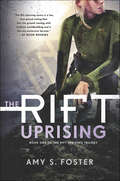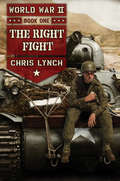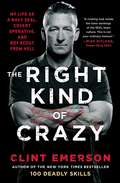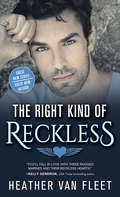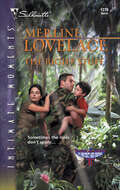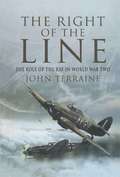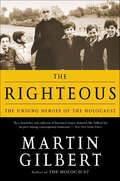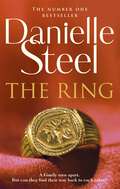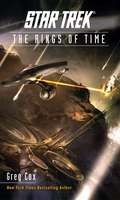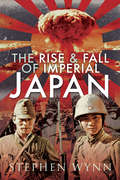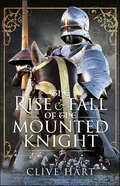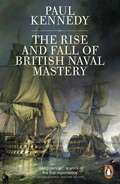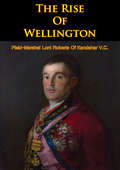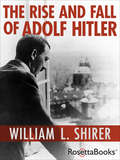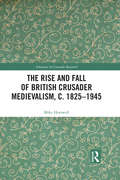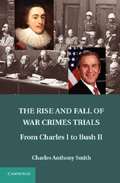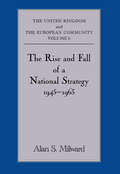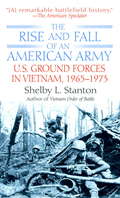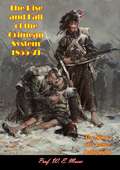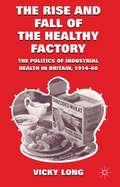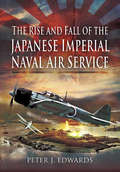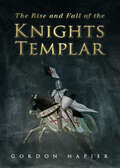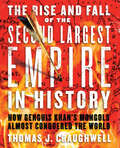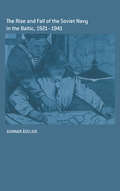- Table View
- List View
The Rift Uprising: The Rift Uprising Trilogy, Book 1 (The Rift Uprising Trilogy #1)
by Amy S. Foster“High emotional stakes and an intriguing premise make this first entry in Foster’s new trilogy a solid next read for those who enjoyed Pierce Brown’s Red Rising or Veronica Roth’s Divergent." -- Library JournalAn alternate reality that feels all-too-real, The Rift Uprising is the explosive start to a new trilogy that blurs the line between parallel universes—not to mention YA and adult science fiction—from acclaimed lyricist and storyteller Amy S. Foster.Normal seventeen-year-old girls go to high school, binge watch TV shows all weekend, and flirt with everyone on the face of the Earth. But Ryn Whitaker is trying to save it.Ryn is a Citadel. A soldier. A liar. Ryn and her fellow Citadels were specially chosen and trained to guard a Rift—one of fourteen unpredictable tears in the fabric of the universe that serve as doorways to alternate Earths. Unbeknownst to her family, Ryn leaves for school each day and then reports for duty as an elite, cybernetically-altered soldier who can run faster, jump farther, and fight better than a Navy SEAL—which comes in handy when she’s not sure if axe-wielding Vikings or any number of other scared and often dangerous beings come through the Rift. A fine-tuned weapon, Ryn is a picture-perfect Citadel.But that’s all about to change.When a young man named Ezra is pulled through the Rift, Ryn finds herself immediately drawn to him, despite her training. What starts as a physical attraction quickly grows deeper, and Ezra’s curiosity throws Ryn off balance when he starts questioning the Rifts, the mysterious organization that oversees them, and the Citadels themselves—questions that lead Ryn to wonder if the lies she’s been telling her family are just the surface of a much bigger lie told to her. As Ryn and Ezra desperately try to get to that truth, they discover that each revelation blurs the line between the villains and the heroes even more.
The Right Fight: The Right Fight (World War II #1)
by Chris LynchThe author of the acclaimed Vietnam series sets his sights on World War II.There are few things Roman loves as much as baseball, but his country is at the top of the list. So when it looks like the United States will be swept up into World War II, he turns his back on baseball and joins the US Army.Roman doesn't mind. As it turns out, he is far more talented with a tank than he ever was with a baseball. And he is eager to drive his tank right into the field of battle, where the Army is up against the fearsome Nazis of the Afrika Korps.The North African terrain is like nothing Roman has ever known, and desert warfare proves brutal. As Roman drives his team deeper into disputed territory, one thing becomes very clear: Life in wartime is a whole new ball game.
The Right Kind of Crazy: My Life as a Navy SEAL, Covert Operative, and Boy Scout from Hell
by Clint EmersonClint Emerson, retired Navy SEAL and author of the bestselling 100 Deadly Skills, presents an explosive, darkly funny, and often twisted account of being part of an elite team of operatives whose mission was to keep America safe by whatever means necessary.Clint Emerson is the only SEAL ever inducted into the International Spy Museum. Operating from the shadows, with an instinct for running towards trouble, his unique skill set made him the perfect hybrid operator. Emerson spent his career on the bleeding edge of intelligence and operations, often specializing in missions that took advantage of subterfuge, improvisation, the best in recon and surveillance tech to combat the changing global battlefield. MacGyvering everyday objects into working spyware was routine, and fellow SEALs referred to his activities simply as &“special shit.&” His parameters were: find, fix, and finish—and of course, leave no trace. The Right Kind of Crazy is unlike any military memoir you&’ve ever read because Emerson is upfront about the fact that what makes you a great soldier and sometimes hero doesn&’t always make you the best guy—but it does make for damn good stories.
The Right Kind of Reckless (Reckless Hearts #2)
by Heather Van Fleet"Sweet, funny, romantic and oh so very sexy! Prepare to swoon mightily." —SAWYER BENNETT, New York Times and USA Today bestselling author of the Cold Fury Hockey seriesMaxwell MartinezI'm in love with a woman I can't have, and there's absolutely nothing I can do to stop myself from falling. The problem? Her brother's my best friend.I shouldn't want her this much. Not when it goes against the bro code. Not when I've never been able to commit to a woman for longer than a night. But one look into her eyes and I'm a mess for her. She's my everything. And I have to walk away with nothing.Reckless Hearts Series: Reckless Hearts (Book 1) The Right Kind of Reckless (Book 2)Recklessly Ever After (Book 3)What People Are Saying About Reckless Hearts: "An emotional, heartfelt, and absolutely beautiful story. I wanted each character to be my best friend. Reckless Hearts was so real, with gorgeous writing that kept me hooked from first page to the last." —JENNIFER BLACKWOOD, USA Today bestselling author of The Rule Book"Van Fleet has mastered the alpha hero. With perfectly flawed characters and miles of scorching heat, Reckless Hearts is a must read!" —KELLY SISKIND, author of A Fine Mess
The Right Stuff (To Protect And Defend Ser. #3)
by Merline LovelaceSix feet, two inches of pure marine male, Major Russ "Mac" McIver had the right stuff in spades. His by-the-book, black-or-white view of the world allowed no compromises. Which tended to ruffle Lieutenant Caroline Dunn's usually unrufflable temper. So when a dangerous mission threw them together, Cari vowed to lay down the law with the stubborn marine--just as soon as she got her leaping heartbeat under control.They locked horns whenever they met. But Mac's one soft spot was Cari. Their battle of the sexes provided a perfect cover for his weakness, but could he keep his secret when they might not have tomorrow?
The Right of the Line: The Role of the RAF in World War Two (Wordsworth Military Library)
by John TerraineTraditionally, the right of the line is the vanguard, the place of honour and greatest danger in battle. In this history of the Royal Air Force during the European War of 1939-45, John Terraine shows how the RAF, which in 1939 was small and inadequate for the task it was called upon to perform had, by the end of the war, taken up its proper position. He describes the build-up to war, the early tests in France and at Dunkirk, the Battle of Britain, the Battle of the Atlantic, the RAF in North Africa and the Mediterranean, the strategic air offensive over Germany and eventual victory in Europe.His best book yet The TimesJohn Terraine is a fine historian but he also believes that history should be exciting and readable The Listener
The Righteous: The Unsung Heroes of the Holocaust
by Martin Gilbert“Important. . . . The very fact that there were so many tales of courage is reason to take heed of this heartening aspect of one of history’s darkest moments.” —Publishers WeeklyDrawing from twenty-five years of original research, eminent historian Sir Martin Gilbert re-creates the remarkable stories of non-Jews who risked their lives to help Jews during the Holocaust.According to Jewish tradition, “Whoever saves one life, it is as if he saved the entire world.” Non-Jews who helped save Jewish lives during World War II are designated Righteous Among the Nations by Yad Vashem, the Holocaust archive in Jerusalem. In The Righteous, distinguished historian Sir Martin Gilbert, through extensive interviews, explores the courage of those who-throughout Germany and in every occupied country from Norway to Greece, from the Atlantic to the Baltic-took incredible risks to help Jews whose fate would have been sealed without them. Indeed, many lost their lives for their efforts.Those who hid Jews included priests, nurses, teachers, neighbors and friends, employees and colleagues, soldiers and diplomats, and, above all, ordinary citizens. From Greek Orthodox Princess Alice of Greece, who hid Jews in her home in Athens, to the Ukrainian Uniate Archbishop of Lvov, who hid hundreds of Jews in his churches and monasteries, to Muslims in Bosnia and Albania, many risked, and lost, everything to help their fellow man.“One of the book’s virtues is Gilbert’s ability to set the local context briefly before recounting the personal stories, thus keeping the human dimension paramount.” —Library Journal“This emotionally stirring book is an essential addition to Holocaust collections.” —Booklist
The Ring: An epic, unputdownable read from the worldwide bestseller
by Danielle SteelTHE WORLD'S FAVOURITE STORYTELLERNEARLY ONE BILLION COPIES SOLD The ring sealed their fate for ever . . .In the turbulent days of Germany in the thirties, Kassandra von Gotthard met the man who would change her life: Dolff Sterne. She was the beautiful wife of a wealthy Berlin banker. He was a famous Jewish writer. Together they shared a love that happens only once in a lifetime. But theirs was a love fated to end in tragedy.The terrible day came when Dolff was wrenched from Kassandra's arms by Nazi soldiers - leaving her heartbroken and humiliated. And Kassandra decided that her life was no longer worth living. All that she leaves for her descendents is her memory of pain and a diamond signet ring. A ring that will carry the destiny of the von Gotthards to new lives and new loves.An epic and romantic tale from one of the best-loved writers of all time. Perfect for fans of Penny Vincenzi, Lucinda Riley and Maeve BinchyPRAISE FOR DANIELLE STEEL:'Emotional and gripping . . . I was left in no doubt as to the reasons behind Steel's multi-million sales around the world' DAILY MAIL'Danielle Steel is undeniably an expert' NEW YORK TIMES
The Rings of Time: The Rings of Time (Star Trek: The Original Series)
by Greg CoxWhen a mining colony on an endangered moon is threatened, it&’s a race against time for the Enterprise crew to find a solution in this original novel set in the universe of Star Trek: The Original Series.The USS Enterprise responds to a distress call from a vital dilithium-mining colony in the Klondike system. The colony is located on Skagway, a moon orbiting Klondike-6, a gas giant not unlike Saturn. For unknown reasons, the planet&’s rings are coming apart, threatening the colony and its inhabitants. Kirk and his crew need to find a solution—fast.There are more than 3,000 colonists, including hundreds of families, on Skagway, which is more than even the Enterprise can take on, and there are no other rescue ships or habitable planets anywhere in the vicinity. Meanwhile, an approaching comet that may be the source of the crisis turns out to be a mysterious alien probe. Sensors indicate that the probe is incredibly old and running low on power. Suspecting that the probe may have something to do with the threat to Skagway, Kirk has the probe beamed aboard the Enterprise. Suddenly after a blinding flash, Kirk suddenly finds himself floating in orbit above Saturn in our solar system, drifting in space wearing a twenty-first century NASA spacesuit. What just happened?
The Rise & Fall of Imperial Japan
by Stephen WynnNearly a century of Japanese Imperial rule, from the 1868 Meiji Restoration to the end of WWII, is explored in this sweeping history.Under Emperor Meiji’s rule, Imperial Japan established itself as a world power through rapid industrialization and militarization. Aligned with the Entente Powers during the First World War, Japan made a proposal for racial equality at the 1919 Paris Peace Conference—only to be overruled by American President Woodrow Wilson. In the 1920s, the empire began its military conquest of numerous countries and islands throughout Asia and the Pacific regions.Author Stephen Wynn examines Japan’s various military conflicts and colonial efforts, including its invasion of China that coincided with the Second World War. The book culminates with the atomic bombs dropped on Hiroshima and Nagasaki, which finally brought about Japan’s surrender and the end of the war in Asia and the Pacific.
The Rise & Fall of the Mounted Knight
by Clive HartThe medieval mounted knight was a fearsome weapon of war, captivating and horrifying in equal measure, they are a continuing source of fascination. They have been both held up as a paragon of chivalry, whilst often being condemned as oppressive and violent. Occupying a unique place in history, knights on their warhorses are an enigma hidden behind their metal armor, and seemingly unreachable on their steeds. This book seeks to understand the world of the medieval knight by studying their origins, their accomplishments and their eventual decline. Forged in the death throes of the Roman Empire, the mounted knight found a place in a harsh and dangerous world where their skills and mentality carved them into history. From the First Crusade to the fields of Scotland, knights could be found, and their human side is examined to see how these men came to both rule Europe, and ride into enduring legend. The challenges facing the mounted knight were vast and deadly, from increasingly professional and competent infantry forces to gunpowder, the rise of political unity and the crunch of finance. The factors which forced the knight into the past help to define who and what they were, as well as the legacy that they have left indelibly imprinted on the world. The standout feature of this book is the focus on the equine half of the partnership, from an author who practices the arts of horsemanship on a daily basis, including combat with sword and lance. The psychology of the horse, refined by the experience of actually training warhorses, has helped the author to add to the body of academic work on the subject. This insight opens up the world of the mounted knight, and importantly and uniquely, challenges the perception of what he and his horse could really do.
The Rise And Fall of British Naval Mastery
by Paul KennedyPaul Kennedy's classic naval history, now updated with a new introduction by the authorThis acclaimed book traces Britain's rise and fall as a sea power from the Tudors to the present day. Challenging the traditional view that the British are natural 'sons of the waves', he suggests instead that the country's fortunes as a significant maritime force have always been bound up with its economic growth. In doing so, he contributes significantly to the centuries-long debate between 'continental' and 'maritime' schools of strategy over Britain's policy in times of war. Setting British naval history within a framework of national, international, economic, political and strategic considerations, he offers a fresh approach to one of the central questions in British history. A new introduction extends his analysis into the twenty-first century and reflects on current American and Chinese ambitions for naval mastery.'Excellent and stimulating' Correlli Barnett'The first scholar to have set the sweep of British Naval history against the background of economic history' Michael Howard, Sunday Times'By far the best study that has ever been done on the subject ... a sparkling and apt quotation on practically every page' Daniel A. Baugh, International History Review'The best single-volume study of Britain and her naval past now available to us' Jon Sumida, Journal of Modern History
The Rise Of Wellington
by Field-Marshal Lord Roberts Of Kandahar V.C.In this short but eminently concentrated biography, Field-Marshal "Bobs" Roberts V.C., who was among the best loved of all British commanding officers reviews the military achievements of one of the most successful British generals, the Duke of Wellington. Eschewing any attempt to cover the Duke's later life in politics or his private life; Lord Roberts focusses on the Duke of Wellington's rise from lowly rank to Napoleon's nemesis at Waterloo. As the author himself begins his book;"THE military career of Wellington naturally divides itself into three periods--the Indian period, the Peninsular period, and the period during which he commanded the Allied Forces in the Netherlands, terminating in the battle of Waterloo. I propose, therefore, in three chapters, relating in turn to each of these periods, briefly to describe the principal incidents of this great soldier's life, and to show how the experience he gained first in the East, and afterwards in South-Western Europe, so developed his natural talents and administrative capacity that he was finally able to meet and overthrow the French Emperor, whose genius for war had up to that date been regarded as absolutely unrivalled."
The Rise and Fall of Adolf Hitler: The Rise And Fall Of Adolf Hitler
by William L. ShirerA concise and timely account of Hitler&’s—and fascism&’s—rise to power and ultimate defeat, from one of America&’s most famous journalists. American journalist and author William L. Shirer was a correspondent for six years in Nazi Germany—and had a front-row seat to Hitler&’s mounting influence. His most definitive work on the subject, The Rise and Fall of the Third Reich, is a riveting account defined by first-person experience interviewing Hitler, watching his impassioned speeches, and living in a country transformed by war and dictatorship. Shirer was originally commissioned to write The Rise and Fall of Adolf Hitler for a young adult audience. This account loses none of the immediacy of The Rise and Fall of the Third Reich—capturing Hitler&’s ascendence from obscurity, the horror of Nazi Germany&’s mass killings, and the paranoia and insanity that marked the führer&’s downfall. This book is by no means simplified—and is sure to appeal to adults as well as young people with an interest in World War II history. &“For nearly 100 years William L Shirer has spoken to us of fascism, Nazis, and Hitler . . . [He] tells the unvarnished truth as he experienced it . . . I figured this school-type book wasn&’t going to tell me anything new. But when I started reading, I realized that I wasn&’t reading for the facts anymore. I listened to his story and heard the urgency in his voice: a voice from nearly 60 years ago telling us the truth about today.&” —Daily Kos
The Rise and Fall of British Crusader Medievalism, c.1825–1945 (Advances in Crusades Research)
by Mike HorswellThis book investigates the uses of crusader medievalism – the memory of the crusades and crusading rhetoric and imagery – in Britain, from Walter Scott’s The Talisman (1825) to the end of the Second World War. It seeks to understand why and when the crusades and crusading were popular, how they fitted with other cultural trends of the Victorian and Edwardian eras, how their use was affected by the turmoil of the First World War and whether they were differently employed in the interwar years and in the 1939-45 conflict. Building on existing studies and contributing the fruits of fresh research, it brings together examples of the uses of the crusades from disparate contexts and integrates them into the story of the rise and fall crusader medievalism in Britain.
The Rise and Fall of Comradeship: Hitler's Soldiers, Male Bonding and Mass Violence in the Twentieth Century
by Thomas KühneThis is an innovative account of how the concept of comradeship shaped the actions, emotions and ideas of ordinary German soldiers across the two world wars and during the Holocaust. Using individual soldiers' diaries, personal letters and memoirs, Kühne reveals the ways in which soldiers' longing for community, and the practice of male bonding and togetherness, sustained the Third Reich's pursuit of war and genocide. Comradeship fuelled the soldiers' fighting morale. It also propelled these soldiers forward into war crimes and acts of mass murders. Yet, by practising comradeship, the soldiers could maintain the myth that they were morally sacrosanct. Post-1945, the notion of kameradschaft as the epitome of humane and egalitarian solidarity allowed Hitler's soldiers to join the euphoria for peace and democracy in the Federal Republic, finally shaping popular memories of the war through the end of the twentieth century. Offers a cultural approach to military history, demonstrating the way in which ordinary soldiers thought, felt, made choices and coped with mass death and violence. Explores the multifaceted fabric of male bonding and how 'hard' and 'soft' features work together. Explains some of the discontinuities in Germany's twentieth century and how those engaged in brutal genocidal violence could then form one of the strongest democracies ever to be established.
The Rise and Fall of War Crimes Trials
by Charles Anthony SmithThis book is the first comprehensive analysis of the politics of war crimes trials. It provides a systematic and theoretically rigorous examination of whether these trials are used as tools for political consolidation or whether justice is their primary purpose. The consideration of cases begins with the trial of Charles I of England and goes through the presidency of George W. Bush, including the trials of Saddam Hussein and those arising from the War on Terror. The book concludes that political consolidation is the primary concern of these trials - a point that runs contrary to the popular perception of the trials and their stated justification. Through the consideration of war crimes trials, this book makes a contribution to our understanding of power and conflict resolution and illuminates the developmental path of war crimes tribunals.
The Rise and Fall of a National Strategy: The UK and The European Community: Volume 1 (Government Official History Series #Vol. 1)
by Alan S. MilwardThis text analyzes British official thinking behind the UK's standing aloof from the moves after 1945 towards European economic collaboration, leading to the establishment of ECSC and the EEC in the 1950s. It deals with the later change of tack (1961), covers the organization in Whitehall for the negotiations with the Communities, and the major problem areas - the Commonwealth, British agriculture, financial implications of British membership, sovereignty, and the future of EFTA.
The Rise and Fall of an American Army
by Shelby L. Stanton“THE MEN WHO SACRIFICED FOR THEIR COUNTRY ARE RIGHTFULLY HERALDED . . . This is an honest book–one well worth reading. . . . Stanton has laid his claim to the historian’s ranks by providing his reader with well-documented, interpretive assessments. ” –Parameters The Vietnam War remains deep in the nation’s consciousness. It is vital that we know exactly what happened there–and who made it happen. This book provides a complete account of American Army ground combat forces–who they were, how they got to the battlefield, and what they did there. Year by year, battlefield by battlefield, the narrative follows the war in extraordinary, gripping detail. Over the course of the decade, the changes in fighting and in the combat troops themselves are described and documented. The Rise and Fall of an American Armyrepresents the first total battlefield history of Army ground forces in the Vietnam War, containing much previously unreleased archival material. It re-creates the feel of battle with dramatic precision. “Stanton’s writing . . . gives the reader a terrifying graphic description of combat in the many mini-environments of Vietnam. ” –TheNew York Times “[A] MOVING, IMPORTANT BOOK. ” –St. Louis Post-Dispatch
The Rise and Fall of the Crimean System 1855-71: The Story of a Peace Settlement
by Prof. W. E. MosseThe Crimean war and the settlement by which it was concluded formed the climax of then-British Prime Minister Palmerston's later diplomacy. In Palmerston's view, much like the war itself, the peace settlement that followed was intended to "to curb the aggressive ambition of Russia. We went to war not so much to keep the Sultan and his Mussulmans in Turkey as to keep the Russians out of Turkey."Apart from material guarantees like the neutralization of the Black Sea and the removal of Russia from all contact with the navigable portion of the Danube and its tributaries, Palmerston sought to achieve his object above all by a policy of diplomatic 'containment,' to construct 'a long line of circumvallation to confine the future extension of Russia,' and thus ultimately prevent any potential future conflict.This book, originally published in 1963, thoroughly examines Crimean system, from its inception and rise, through to the initial signing of the Triple Treaty on 15 April 1856, its subsequent testing time, and the eventual demise of the Crimean system.The detailed study seeks to provide the reader with some answers to the general questions that arise with the implementation of international engagements, such as:"What is the value of a unilaterally imposed peace settlement? Do treaties of guarantee serve any useful purpose? What, in general, is the relationship between original intent at the signing of a treaty and the policy or will of the given moment? Will any government, in fulfilment of treaty obligations, pursue a line of policy to which it is not otherwise inclined? Will a government in pursuance of obligations contracted years before, act in opposition to the 'national interest' of the moment? In short, is there such a thing as the much proclaimed 'faith of treaties'?"
The Rise and Fall of the Healthy Factory
by Vicky LongThe first account of the emergence and demise of preventive health care for workers. It explores how trade unions, employers, doctors and the government reconfigured the relationship between health, productivity and the factory over the course of the twentieth century within a broader political, industrial and social context.
The Rise and Fall of the Japanese Imperial Naval Air Service
by Peter J. EdwardsThis book describes in considerable detail the people, events ships and aircraft that shaped the Air Service from its origins in the late 19th century to its demise in 1945. The formative years began when a British Naval Mission was established in Japan in 1867 to advise on the development of balloons for naval purposes. After the first successful flights of fixed-wing aircraft in the USA and Europe, the Japanese navy sent several officers to train in Europe as pilots and imported a steady stream of new models to evaluate.During World War One Japan became allied with the UK and played a significant part in keeping the German fleets of ships and submarines at bay in the Pacific and Indian Oceans. However, in the international naval treaties that followed they felt betrayed, since the number of capital ships, battleships and cruisers, that they were allowed was below those of the USA and the UK.Aircraft carriers were not included, so a program of carrier building was started and continued until World War Two. At the same time they developed an aircraft industry and at the beginning of war their airplanes were comparable, and in some instances superior, to those of the British and Americans.Much prewar experience was gained during Japans invasion of China, but their continued anger with America festered and resulted in their becoming allied with Germany, Italy and the Vichy France during World War Two. There followed massive successful attacks on Pearl Harbor, the Philippines, the Southern Islands, Port Darwin and New Guinea.The British were decimated and the USA recoiled at the onslaught, taking over a year to regroup and take the war to the Imperial Japanese forces. Throughout the conflict many sea battles were fought and the name Zero became legendary. When Japan eventually capitulated after the Atomic bombs were dropped the Japanese Imperial Air Service was disbanded.
The Rise and Fall of the Knights Templar: The Order of the Temple 1118-1314 - A True History of Faith, Glory, Betrayal
by Gordon NapierA highly readable look at the lifespan of the famous Knights Templar, who were warrior monks and the first disciplined, regulated, and uniformed standing army since antiquity throughout Europe and the Holy Lands—an economic force to be reckoned with and perhaps an institution guarding dark secrets. The origins of the concept of Holy War are explored, from Biblical times through the rise of Islam and the Christian movement, which inspired untold thousands to set out to recapture Jerusalem, as warriors and as pilgrims. This book explains how nine knights led by Hugues de Payens came from France to guard pilgrims in the Holy Land, how they gained the site of the Temple of Solomon, and what they did there, including a reevaluation of the historical evidence. Other topics discussed include how an unprecedented religious Order grew and pledged to bloodshed in defense of pilgrims, the territory conquered by the Crusaders, and the role and agenda of Saint Bernard of Clairvaux and other powerful backers. The Order's contribution to the ongoing Crusades is explained, as well as their military tactics and organization and the fortresses and bases they established. Discussion of the fate of the Order after the failure of the Crusades includes a detailed examination of the charges of occult rituals involving idol worship, spitting on the Cross, and obscene kisses, through to the burning of the last Grand Master Jacques de Molay in 1314.
The Rise and Fall of the Second Largest Empire in History: How Genghis Khan's Mongols Almost Conquered the World
by Thomas J. CraughwellHow Genghis Khan and the Mongols conquered nearly one-sixth of the planet: “The fascinating story of history’s most misunderstood empire builders.” —Alan Axelrod, bestselling author of Miracle at Belleau WoodEmerging out of the vast steppes of Central Asia in the early 1200s, the Mongols, under their ferocious leader, Genghis Khan, quickly carved out an empire that by the late thirteenth century covered almost one-sixth of the Earth’s landmass—from Eastern Europe to the eastern shore of Asia—and encompassed 110 million people. Far larger than the much more famous domains of Alexander the Great and ancient Rome, it has since been surpassed in overall size and reach only by the British Empire.The Rise and Fall of the Second Largest Empire in the World recounts the spectacularly rapid expansion and dramatic decline of the Mongol realm, while examining its real, widespread, and enduring influence on countless communities from the Danube River to the Pacific Ocean.“Great sweeping history from a superb writer.” —Joseph Cummins, author of The War Chronicles“A skillful and imaginative storyteller and conscientious historian.” —David Willis McCullough, author of Wars of the Irish Kings
The Rise and Fall of the Soviet Navy in the Baltic 1921-1941
by Gunnar ÅseliusThis book, based on extensive work in Russian archives, investigates how strategy, organisational rivalry and cultural factors came to shape naval developments in the Soviet Union, up to the invasion of 1941. Focussing on the Baltic Fleet, the author shows how the perceived balance of power in northern Europe came to have a major influence on Sovie
